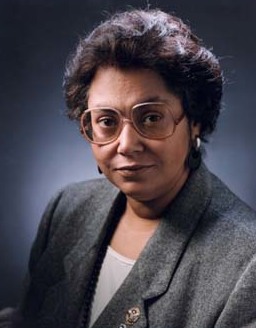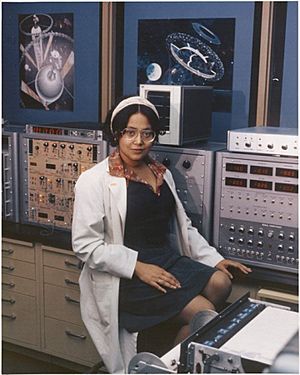Patricia S. Cowings facts for kids
Quick facts for kids
Patricia S. Cowings
|
|
|---|---|

NASA photograph of Dr. Patricia S. Cowings
|
|
| Born |
Patricia S. Cowings
December 15, 1948 The Bronx, New York City, New York, U.S.
|
| Education | State University of New York at Stony Brook (BA Psychology); University of California Davis (MA Psychology; Ph.D. Psychology) |
| Occupation | Psychophysiology |
| Spouse(s) |
Dr. William B. Toscano
(m. 1980) |
| Parent(s) |
|
| Awards |
|
Patricia S. Cowings was born on December 15, 1948. She is a scientist who studies how the mind and body work together, especially in space. She was the first American woman trained as a scientist astronaut by NASA. Although she was chosen as a backup for a space mission in 1979, she didn't get to go to space. Dr. Cowings is famous for her research on how astronauts' bodies react in space. She also found ways to help them with space sickness.
Contents
Early Life and Education
Patricia Cowings grew up in The Bronx, New York City. She was born on December 15, 1948. Her parents were Sadie B. and Albert S. Cowings. Her mother was a preschool teacher's assistant. Her father owned a grocery store. Patricia had three brothers. They grew up to be a two-star army general, a jazz musician, and a journalist. Her parents taught them that education was very important.
Patricia loved science from a young age. She earned a bachelor's degree in arts from the State University of New York at Stony Brook in 1970. She then studied psychology and psychophysiology. These fields taught her how to help people reach their full potential. She was inspired by her aunt, who was also a psychologist. Patricia earned her psychology degrees from the University of California, Davis in 1973. While in graduate school, she took an engineering class. She helped design a space shuttle. This experience made her want to work in space technology.
Working with NASA
Dr. Cowings started working at NASA in 1971. She was a graduate student at the time. She received a special fellowship to do research. In 1979, she became the first African American woman scientist trained as an astronaut by NASA. Even though she never flew to space, she spent 34 years researching how gravity affects the human body.
Most of her research happened at the NASA Ames Research Center. She created a special training system. It is called Autogenic-Feedback Training Exercise (AFTE). This system helps people learn to control their own body responses. They can learn to control up to 24 different body reactions in just six hours.
Her work was first tested in 1985. It was used on the STS-51B and STS-51C shuttle flights. These were the Spacelab-3 and the first DOD shuttle missions. Her AFTE training method was also tested on the Space J-Lab Mission. This was the first Japanese shuttle mission. Her main goal was to help astronauts avoid motion sickness.
Later, she trained four cosmonauts. They learned to control both motion sickness and low blood pressure. This was after they spent six months on the MIR space station. Her methods were very successful. She also developed a tool to easily check astronauts' body responses in space.
Helping Astronauts with Space Sickness
Dr. Cowings' most important invention is the AFTE program. This program helps astronauts deal with space motion sickness. The AFTE teaches future astronauts to control up to 20 body responses in space. This helps them overcome sickness and do their work. These responses include heart rate, skin changes, muscle reactions, and blood pressure. All these things can be affected by space and the lack of gravity.
Why the AFTE Was Needed
Dr. Cowings wanted to solve problems astronauts faced in space. She wanted to find ways to help them adapt faster without using medicine. In the early 1980s, she saw that many astronauts got space sickness. She studied how it affected their minds and bodies.
First, she made test subjects feel sick to observe them. Then, she created a program to help astronauts fight the sickness. The program took only six hours in total. It involved 12 half-hour sessions. These sessions combined training and biofeedback. This allowed astronauts to control their reactions instead of being overwhelmed by them.
How the AFTE Helps
The AFTE program helps astronauts control their bodies. It prevents the sickness that can slow down their adaptation to space. With AFTE training, astronauts can better control their heart rate and breathing. They can also control blood flow to their hands.
At the start of their training, participants received feedback. This feedback showed them how to control their responses. Gradually, they learned to do it on their own. These repeated exercises helped astronauts feel more comfortable in space. It helped them adjust to space conditions faster. This allowed them to complete their missions more quickly.
Legacy and Awards
Dr. Cowings' AFTE program is still used today. Its use has also grown into the medical field. Today, Dr. Cowings and her team prepare astronauts for the tough conditions of space using AFTE.
She has also expanded the use of AFTE to help hospital patients. It helps people with various conditions, like stomach problems. At the Morehouse University School of Medicine in Atlanta, AFTE helps patients with blood pressure, nausea, and high blood pressure.
Dr. Cowings continues her work to prevent space sickness in astronauts. She also helps them control motion sickness when they return home. She leads the Psychophysiological Research Laboratories at NASA Ames Research Center. She has also taught at UCLA and the Uniformed Services University.
Throughout her career, she has received many awards for her research and teaching. These include:
- Candace Award from the National Coalition of 100 Black Women (1989)
- NASA Individual Achievement Award (1993)
- Black Engineer of the Year Award (1997)
- AMES Honor Award for Technology Development (1999)
- NASA Space Act Award for Invention (2002)
- National Women of Color Technology Award (2006)
- NASA Space Act Board Award (2008)
- Ames African American Advisory Group's (AAAG) Achievement Award (2010)
- Celestial Torch Award from the National Society of Black Engineers (NSBE) in Los Angeles (2014)
See also
 In Spanish: Patricia Cowings para niños
In Spanish: Patricia Cowings para niños


